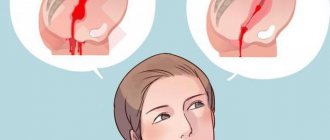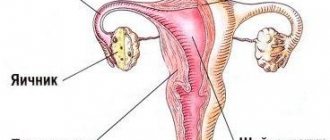What to do if the intimate area and discharge smell unpleasant after childbirth
Many women experience discharge after childbirth that has a specific unpleasant odor. This may be due to insufficient personal hygiene, since in the postpartum period it must be more thorough. In addition, a bacterial or fungal infection may be associated, which requires additional examination and sampling to identify the pathogen.
Personal hygiene and healthy eating
Careful care of the intimate area will help overcome unpleasant odor from the vagina. Mom needs to wear breathable underwear that does not cause discomfort or constriction.
You need to change sanitary pads every 2 hours to avoid causing infection. You can use night pads, special postpartum or disposable diapers.
You need to wash yourself after every trip to the toilet, rinsing the intimate area. It is better to use neutral baby soap without fragrances or dyes.
Poor nutrition also affects the smell of discharge. It is necessary to eat foods containing useful substances and microelements. Diet is also important when breastfeeding, because some foods can cause allergic reactions and upset the digestive system in a child.
Drug therapy
If the doctor has determined the cause of the foul-smelling discharge, the woman is prescribed medication. Drugs are selected on an individual basis, since many medications are prohibited during breastfeeding. Drug therapy may include:
- anti-inflammatory drugs;
- antibiotics (Ampicillin, Metronidazole);
- antipyretic drugs (Paracetamol);
- painkillers (No-Shpa).
Doctors often prescribe Oxytocin to help the uterus contract and facilitate the passage of breast milk. Typically, therapy is carried out immediately after birth and lasts up to 5 days.
For serious pathologies, specialists resort to systemic therapy. Sometimes a woman is advised to stop breastfeeding her baby for a while. In this case, it is necessary to express.
Folk recipes
To relieve inflammation of the vaginal mucosa and eliminate unpleasant odor after childbirth, women often resort to folk remedies. It must be remembered that self-medication can cause complications and allergies, so before using any remedy, you will need to consult a specialist. Some traditional methods are described in the table:
| Folk remedy | Mode of application | Action |
| Tea tree oil | Add a few drops of oil to 0.5 liters of boiled water and use to wash the intimate area. | Relieves inflammation and is a good antiseptic |
| Oak bark, chamomile, sage and nettle | Dry plants in equal quantities (1 tbsp.) Pour boiling water (1 l) and let it brew for half an hour, then strain. Wash with warm herbal infusion | Has an astringent effect, stops the inflammatory process, and has a hemostatic property. |
| St. John's wort | Pour a glass of boiling water over the dry herb (1 tablespoon) and cook over low heat for about 20 minutes. The infusion is taken orally, one-third of a glass three times a day. | Has anti-inflammatory and restorative effects, restores the body's defenses, heals wounds |
| Birch leaves | The dry plant (2 tbsp.) is crushed and poured with boiling water (0.5 l). Take a whole glass of infusion once a day for a week. In this case, it should take about two weeks after birth | Strengthens the body, relieves inflammation |
To ensure that the recovery process after childbirth occurs without complications and unpleasant symptoms, experts recommend carefully monitoring your personal hygiene and not skipping routine examinations with a gynecologist. Preventive measures also include:
- Frequent visits to the toilet to empty your bladder in a timely manner. This measure will reduce the load and pressure on the uterus.
- Put the baby to the breast more often. This will allow the uterus to recover faster, since breastfeeding helps contract the uterine muscles.
- During the entire recovery period (until vaginal discharge stops), you should not visit saunas, swimming pools, baths, or take a bath. Only warm showers are allowed.
- Change pads every 2-3 hours, wash with warm water and herbs (chamomile, string, calendula). The use of tampons is prohibited, since this disrupts the natural process of leakage of lochia and creates favorable conditions for the proliferation of pathogenic microflora.
- You can begin sexual activity only after consulting a doctor (we recommend reading:). In this case, the use of a condom is mandatory to avoid infection of the intimate area.
How to help yourself
All women who are faced with this problem think about how to make their lives easier and eliminate unpleasant symptoms. The smell that arises in lochia after childbirth brings considerable discomfort to the young mother and frightens her very much. Sometimes women look for a way out of this situation on their own, without consulting a doctor. Very often, young mothers, due to lack of time, use traditional methods, listen to the advice of friends, or completely ignore the ailment.
It is important to remember that you should never self-medicate!
After the pregnancy period, this is strictly prohibited, as there is a possibility of irreparable complications and even death.
Read also No period after childbirth for 2, 4, 5, 6, 7, 8, 9 months or longer
Here's how you can help yourself without harming your health:
- Follow the rules of hygiene (you need to wash yourself very often - after each visit to the toilet).
- To soothe irritated skin, you can use herbal decoctions (chamomile, calendula, string, sage).
- Taking a bath is strictly prohibited, only showering is allowed.
- You should not visit the bathhouse, sauna or swimming pool.
- Intense physical activity should be avoided.
- Training in the gym is strictly prohibited.
- It is better to use condoms during intimacy.
- Breastfeed your baby more often (regular latching will help the uterus contract faster).
- For better contraction of the abdominal muscles, it is recommended to spend most of the time on the stomach (during rest and sleep).
- Even if there is no urge, you need to visit the toilet regularly.
It is very important to monitor your health. The body is now very weakened and any infection or virus can easily penetrate it. To avoid this, you need to protect yourself: use condoms during sexual intercourse, take a complex of vitamins, eat plenty of vegetables and fruits, and monitor the level of iron in your blood.
Symptoms
Just from one symptom - vaginal discharge - you can tell a lot about the probable cause of the disorders. Therefore, during a gynecological examination or retrospectively (based on complaints and anamnesis), the doctor assesses their nature:
- Type: bloody, mucous, purulent.
- Volume: abundant or scanty.
- Color: reddish, whitish, yellow-green.
- Consistency: liquid, creamy, “curdled”.
- Smell: blood or dampness, urine, purulent, rotten or putrid, sour, fishy.
Discharge may increase after physical activity or sexual intercourse, and in some cases it does not depend on external factors at all. But the symptoms do not end there, because pathological conditions are accompanied by other manifestations. Based on the totality of signs, it is possible to form a preliminary diagnosis.
Endometritis
After the birth of a child, the uterus is a large wound surface into which microorganisms can penetrate under inadequate hygienic and anti-epidemic conditions. Then we talk about endometritis, the most common form of postpartum infections. In 75% of cases it occurs in a mild form. Symptoms develop on days 5–12:
- Pain in the lateral abdomen.
- Bloody-purulent discharge with an odor.
- Increase in body temperature to 38–38.5 degrees.
But the general condition of the woman in labor still remains satisfactory, which cannot be said about severe cases, when already on the 2-3rd day a severe fever and general weakness occur, the pulse quickens, and a headache appears. Most often, such endometritis occurs after cesarean section and in women with extragenital pathology.
Specific infections
Infections such as trichomoniasis, chlamydia, candidiasis, gardnerellosis, and gonorrhea are common causes of inflammation of the genital tract. Even after childbirth, discharge with an unpleasant odor can be caused by specific pathogens. In this case, colpitis (vaginitis) most often occurs, but nothing prevents the pathological process from spreading higher, which is facilitated by late seeking medical help.
Based on the appearance of the discharge and its organoleptic characteristics, one can assume the probable causative agent of the infection:
- Gonorrhea is yellow-green in color and thick, with a corresponding “purulent” odor.
- Trichomoniasis - greenish, liquid and foamy, with the smell of rotten fish.
- Candidiasis - white, cheesy consistency, with a sour smell.
But among the subjective symptoms, such conditions have much in common, since they are characterized by inflammation of the mucous membrane of the vagina and vulva, and often the urethra. Therefore, women will experience the following symptoms:
- Burning and itching in the vagina.
- Discomfort and pain during sexual intercourse.
- Pain while urinating.
- Redness of the external genitalia.
If such signs were observed even before birth, then it is likely that the child who passed through the infected pathways could even become infected.
Vaginal fistulas
If the discharge smells like urine, then the cause may be hidden in the fistulous tract connecting the vagina with the urethra or bladder. Most often they form after mechanical damage to tissue during childbirth. Consequently, even in physiological secretions there will be an admixture of urine, and its amount depends on the size of the fistula. There will be other symptoms:
- Pain in the vaginal and bladder areas.
- Increased urination.
- Cutting and burning.
Of course, this situation is extremely unpleasant, and with large fistulas it becomes an obstacle to sexual life and even social contacts. And despite the fact that minor defects can heal on their own, they need to be eliminated as soon as possible.
What should be the norm?
The process of restoring a girl’s body takes quite a long time. At this point, it is important to monitor the nature of secretions from the vagina and how long they last after childbirth.
In the first two days, the separation of scarlet bloody fluid is considered normal. The wound surface is still injured during each uterine contraction. Such discharge after childbirth should not smell at all. Further, the lochia becomes less abundant, acquiring a brown tint. After a few days (usually 7-10), you may notice that the color has become yellowish or creamy. This stage of discharge after childbirth completely stops after a certain time: from 40 to 60 days. Ideally, nothing should bother a woman during this period.
With intensive sports, frequent breastfeeding, and physical activity, the amount of secretion may increase slightly.
Itching, burning, irritation of the mucous membrane during lochia, changes in color and smell should alert you and become a good reason for visiting a doctor. It is important to monitor how long the discharge lasts after childbirth. If they ended much earlier than expected, this is not a reason for joy and pride, in the hope of a quick recovery. Such a signal is not simple and makes it clear that the placenta particles have not completely come out and further complications may arise. The extended period should also not be ignored. This is a clear sign that not everything is fine with the body.
Read also: Diarrhea after childbirth in women: causes, treatment
What is considered normal discharge
So, over the course of 6-8 weeks, when the female body recovers after childbirth, it returns to its “original” parameters: the pelvic bones fall into place, the configuration of the spine changes, the walls of the vagina narrow, and at the same time the skin and abdominal muscles tighten.
But especially important changes at this time occur in the uterus, which begin immediately after the placenta is separated from its inner surface (regardless of how the child was born - by cesarean section or through the natural birth canal). The uterus begins to contract, shrink to its normal state. The separation of the placenta is accompanied by a kind of trauma to the inner surface of the uterus, so for 2-3 days it is accompanied by fairly strong bloody discharge, called lochia.
Over time, lochia, which does not have a distinct odor or smells like normal menstrual discharge, changes its intensity, consistency and color, and this should be paid attention to (even if the discharge is not particularly bothersome). On days 6-7 after birth, lochia becomes less abundant and acquires a brown tint, but it can become a little more intense if a woman is breastfeeding or has physical activity.
They may also intensify when coughing or laughing, but this is a normal manifestation of more active contraction of the muscles of the abdominal cavity, and with them the uterus.
Discharge is considered normal if it is not accompanied by unpleasant sensations such as irritation, itching, does not have an unpleasant odor, and has completely stopped 45-60 days after birth.
As soon as the discharge has stopped (before or after the specified time), women are recommended to undergo a gynecological examination so that the doctor can assess the condition of the uterus, its cervix, vagina and sutures.
What awaits a young mother in the hospital?
After contacting the doctor with complaints about the unpleasant smell of postpartum discharge, the woman will need to tell in detail how the birth went, how and when the smell appeared, and undergo a gynecological examination. To make a diagnosis you may also need:
- Pregnancy and childbirth card;
- Microflora smears and PCR;
- Results of blood and urine tests;
- Tests for STDs;
- Ultrasound of the abdominal cavity.
Carrying out all the examinations will take a little time, but do not refuse them, citing being busy with the baby. The appearance of discharge with an unpleasant odor during the postpartum period is a dangerous symptom.
Discharge after childbirth with an unpleasant odor
Discharge after childbirth with an unpleasant odor is a reason for close attention to the woman. Experts note that discharge after childbirth with some “spicy” or musty odor may be normal, because in some way menstruation also smells of iron. Also, postpartum suckers have a very specific smell. But sometimes the smell of postpartum discharge becomes especially unpleasant - in this case, you need to seriously think about the state of the body. It is advisable to consult a doctor who will help determine the cause of its occurrence.
Discharge with an unpleasant odor
In the first month and a half after giving birth, there are suckers. This is a normal reaction of the body to the birth process. After all, along with such secretions, blood clots will come out after childbirth, as well as remnants of the placenta, endometrial particles, blood from the uterus, and other elements. If the discharge after childbirth has a specific smell, then this is not a cause for concern. The main thing to remember is the need to observe the rules of personal hygiene, regularly change pads and wash yourself. At this time, visiting saunas and other public places where there is a high risk of infection is not allowed. After one and a half to two months, the suckers will stop.
If the discharge after childbirth has an unpleasant odor, this may be the first signal of the onset of an inflammatory process in the uterus, so this situation requires immediate consultation with a doctor.
So, consultation with an obstetrician-gynecologist is necessary in cases where:
- the suckers have acquired a yellow-green or bright yellow color, as well as an unpleasant odor;
- if the smell of postpartum discharge has become clearly putrid and repulsive;
- blood clots occur after childbirth or the volume of discharge is too large.
Any of the symptoms described above indicates deviations from the norm in the female reproductive system and inflammation in it. One way or another, when the smell of a woman’s postpartum discharge becomes unpleasant, this is a reason to be wary.
Discharge after childbirth with an unpleasant odor - what is it?
The appearance of an unpleasant odor of postpartum discharge is the body’s very first signal for help.
First of all, it is important to find out what led to his condition, and self-treatment in such cases is unacceptable. Only the gynecologist observing the woman can select the optimal treatment.
Even if the postpartum discharge does not have an unpleasant odor, but it turns greenish, reddish or rich yellow, this is a signal about the beginning of a pathological process in the body.
The same applies to the appearance of blood clots in the lochia. The most dangerous reason for their appearance, as well as the unpleasant odor of postpartum discharge, is inflammation of the uterus. Typically, this condition is accompanied by a sharp deterioration in the woman’s well-being, fever, headaches, and pain in the lower abdomen.
First of all, as soon as discharge after childbirth with an unpleasant odor is noted, an additional ultrasound is required, because often the cause of this condition is the placenta that has not completely left the uterus. It must be removed immediately to avoid dire consequences.
It is possible that an unpleasant odor may appear due to infection in the genital tract. Therefore, the woman is asked to undergo a series of tests to determine the specific disease and its subsequent treatment.
Causes of unpleasant odor in discharge after childbirth
Experts call endometritis, that is, inflammation of the uterine mucosa, as the most common cause of an unpleasant odor in postpartum discharge. This disease is characterized by the appearance of green or yellow-brown mucous discharge with an unpleasant putrefactive odor. Particularly severe cases are accompanied by chills and fever. Treatment of endometritis will require medical supervision, and self-medication is strictly unacceptable.
In addition, the unpleasant smell of discharge after childbirth may be evidence of stagnation of lochia in the uterus itself, that is, difficulty in their exit. Then, to avoid rotting of this mass, scraping will be required.
Sometimes the cause of an unpleasant odor lies in infectious diseases of the genital tract such as chlamydia, gardenellosis and others. To make an accurate diagnosis, an examination will be required, based on the results of which suitable treatment will be prescribed.
Diagnostic methods
It is necessary to pay careful attention to such conditions, as they are fraught with consequences and can cause significant harm to a woman’s health. If a young mother suspects some kind of infection, she should consult a doctor for examination and examination. The main methods used to diagnose the condition are:
- general gynecological examination;
- vaginal smear for flora, culture of contents;
- PCR and culture for major pathogenic microorganisms;
- ultrasound examination of the uterine cavity;
- General and biochemical blood test.
If necessary, the list can be expanded.
Unpleasant odor in the intimate area after childbirth: causes and treatment
Nine months of waiting and labor pains are over. The baby is healthy and sleeps almost all the time. It would seem that everything should return to normal and the woman’s health should be restored. Her body has done a great job. But in the postpartum period, this load can make itself felt. And one of the signs of trouble is discharge with an unnatural and unpleasant odor. What are their reasons, and what should a new mother do in this case? Let's look into it in detail.
What Causes Bad Vaginal Odor?
After the placenta has separated from the uterus, menstrual-like discharge comes out of the mother's vagina. Gynecologists call them lochia. In the first 5-7 days they are profuse, red, with mucus. Their color gradually changes. Postpartum discharge becomes light brown, then its color approaches physiological. This period takes 4-6 weeks.
Typically, lochia does not have a strong odor. They do not cause discomfort to others, or unpleasant and painful sensations to the mother in labor. If after a week the postpartum discharge has not changed, has not become light brown, and besides, it has a specific pungent odor, then the woman should consult a doctor with this problem. A putrid “aroma” in combination with heavy discharge is most likely evidence of the development of an acute inflammatory process in the uterus. This is probably endometritis. And although a woman in the postpartum period is entirely devoted to caring for the baby, this is not a reason to ignore problems with her own health or self-medicate. You should consult a doctor if suddenly the transparent lochia becomes scarlet, bloody, or purulent. You also need to rush to the doctor when, along with the appearance of the smell, the temperature rises, pain appears in the lower abdomen, and it radiates to the lower back.
The cause of endometritis is the entry of pathogenic microflora into the uterus and the development of an infectious process. This condition will not go away on its own. Endometritis is treated under the supervision of a gynecologist, because it can sometimes cause death in postpartum women!
As for other causes of bad odor from the birth canal, these may be:
- Vaginosis. This is an inflammation of the vaginal walls, provoked by various microorganisms.
- Candidiasis. A disease caused by fungi of the genus Candida. Candidiasis is characterized by white discharge. Their structure is cheesy. The smell is sour. This postpartum complication is not as dangerous as endometritis. It is easily treated.
- Diseases of the urinary system. During a period of sharp decline in immunity, women can “catch” cystitis and pyelonephritis, which, in addition to the unpleasant odor of the discharge, are also accompanied by pain.
- Vaginal dysbiosis. The disease also develops against the background of a decrease in the body's defenses and is accompanied by a foul odor.
What to do to eliminate odor in the intimate area after childbirth
First of all, you need to accurately determine its cause. Endometritis should be treated by a gynecologist, prescribing antibacterial drugs, taking into account whether the woman is breastfeeding. Local remedies are also prescribed in the form of creams, gels, aerosols and suppositories.
The drugs Metrogyl, Trichopolum, Metronidazole can be used in the form of suppositories or tablets. Antimicrobial drugs in the treatment of endometritis are combined with douching with Tomicide and Benzalkonium chloride. Local therapy does not have a systemic effect on the body of a nursing woman. It has minimal side effects.
Vaginal dysbiosis is also treated with antibiotics. For this purpose, Clindamycin, Oleandomycin and cephalosporins are used. Gynoflor suppositories are also prescribed for dysbacteriosis.
If the cause of the unpleasant odor is thrush, then you can use suppositories Terzhinan, Isoconazole, Lomexin. Vaginosis is treated with Iodoxide.
During the period of therapy, a woman should take care of strengthening her immunity, enriching her diet with vitamins, juices, and berries.
It is also important to change pads more often, maintain personal hygiene more carefully, and wear loose underwear made of natural fabric. Do not use untested hygiene products for the intimate area
Vaginal discharge by color
Almost all unusual leucorrhoea is accompanied by a not very pleasant odor, which, again, can be caused by inflammatory processes. Basically, this is a curdled discharge mixed with pus.
Brown discharge
Discharge of a light, brownish hue is possible if a woman forgets about personal hygiene. As a result, the acidic environment of the vagina changes, and the discharge acquires a characteristic color and unpleasant odor.
This shade of leucorrhoea is characteristic during the onset of menstruation and after it, and also occurs against the background of hormonal changes.
Almost black color in combination with pain in the lower pelvic area is very dangerous, and you need to urgently check for the presence of an ectopic pregnancy. If noticeable drops of blood or pus are added to all this, then perhaps this is caused by one of the types of endometrial inflammation.
Pink discharge
Leucorrhoea of a pale pink color accompanies injury or pathology of the walls of the vagina or uterus, inflammation. Inflammatory processes are usually caused by sexually transmitted infections, after unsafe sexual intercourse, from an infected partner. These include:
- chlamydia;
- gonorrhea;
- mycoplasmosis.
Green discharge
This shade is associated with an increased level of leukocytes in the blood and accompanies inflammation of the genitourinary system.
A “fishy” smell occurs due to vaginal dysbiosis and such an unpleasant disease as gonorrhea. Trichomonas, the bacteria that cause trichomoniasis, may also be responsible for this odor and color. Another reason is cervical erosion.
If after the process of defecation the amount of discharge increases, it is viscous and thick, then perhaps we are talking about cervicitis. Most likely, it began to progress, releasing pus.
In addition to green leucorrhoea, the following may be observed:
- severe nagging pain;
- general fatigue;
- dizziness;
- elevated body temperature.
Yellow discharge
A frequent sign of pathologies and inflammation. Bacterial vaginitis is one of the variants of the formation of yellow leucorrhoea with a rotten odor. Colpitis and salpingitis are frequent friends of yellowish leucorrhoea.
All this can be caused by gynecological diseases caused by viruses or bacteria.
Gonorrhea is characterized by yellowish-green leucorrhoea. Patients experience itching and difficulty urinating. A woman experiences similar symptoms with trichomoniasis. Interspersed with pus can be due to chlamydia. Pain experienced during sexual intercourse may increase every day.
Gray discharge
Curdled white leucorrhoea with a gray tint is a possible symptom of the well-known thrush. Redness, noticeable to the naked eye, burning sensation and an irresistible desire to scratch the affected area of the labia are a clear sign of an advanced disease. At the same time, a sour aroma from the vagina also appears.
Green discharge
As already mentioned, if lochia does not have a pronounced rotten aroma and does not cause any particular inconvenience, then the restoration process proceeds normally. But if the secretion takes on a green tint, this is already a signal of deviation. Green discharge with an odor indicates the presence of pus in it. Often this means the progression of the inflammatory process, but in rare cases it indicates that the lochia does not drain well, accumulates and begins to rot.
Endometritis
Endometritis is inflammation of the lining of the uterus. This illness is difficult for mothers to endure, as it is accompanied by high body temperature and pain in the lower abdomen. For an organism that is fragile after the birth of a baby, illness is still a test.
The cause of endometritis lies in the slow contractility of the uterus, as a result of which lochia accumulates inside the genital tract and begins to rot. Most often, the problem is solved by performing a curettage procedure.
Bacterial vaginosis
It is also called vaginal dysbiosis, that is, an imbalance of microorganisms. Often the pathology does not manifest itself, only analysis of the secretion can reveal abnormalities
The disease is dangerous because it can provoke the same endometritis, as well as the less dangerous mastitis (purulent inflammation of the mammary gland), so it is very important to promptly identify any bacterial disorders
Thrush
Thrush is the same disorder of the microflora of the uterus, in which the amount of Candida fungus increases. In addition to greenish secretions in the early postpartum period, thrush is accompanied by itching at the entrance to the vagina, as well as painful urination, pain in the nipples during feeding.
The child is also susceptible to this disease during the sexual tract or through breast milk. The fungus will develop in the baby's mouth.
Gonorrhea
Gonorrhea is an infectious disease that develops in the genitourinary system. The main symptoms are the identification of purulent secretion, ulcers on the mucous membranes, their swelling, pain and burning during urination, heaviness in the lower abdominal cavity, and fever.
Trichomoniasis
This disease is dangerous because it is difficult to identify, since its symptoms are similar to those of other bacterial diseases. Among the main symptoms, one can emphasize abundant greenish-yellow secretion, burning in the vaginal area, swelling of the labia, increased body temperature, and an unpleasant odor in the intimate area.
All these diseases are united by green secretion, often foamy consistency, redness and itching of the vagina.
When you can't do without a doctor's help
When lochia after childbirth has a sharp, rotten aroma and is accompanied by a serious deterioration in well-being, medical intervention is indispensable. A girl should be especially careful if she notices several strange symptoms. Very often, deviations from the norm signal that the body has malfunctioned, inflammation or infection has begun.
Read also What suppositories can be used for hemorrhoids after childbirth: inexpensive and good
You need to pay close attention to the following signs:
- lochia ended a whole month ahead of schedule (clots may accumulate in the uterus and an inflammatory process may begin);
- discharge is abundant and lasts a long time (leads to anemia);
- there is aching pain in the lower abdomen, as well as increased body temperature (a sign of the onset of serious complications).
In order to discover the cause of the disease, you should visit a qualified gynecologist. After a personal examination and examination, we can talk about the details of the necessary therapy.
The examination usually consists of:
- blood, urine and vaginal smear tests;
- ultrasound examination of internal organs;
- inspection and conversation.
It is important to choose a doctor who examined you during pregnancy and knows the details of the birth process of the baby. It will be easier for the doctor to understand, taking into account all the subtleties and details of a particular case.
After childbirth, discharge with an unpleasant odor - possible consequences
The consequences of unpleasant odor of vaginal discharge go far beyond aesthetic limits and can be dangerous to a woman’s health.
Common vaginosis, for example, irritates the mucous membrane and makes the genitourinary system vulnerable to various infections. This is why bacterial vaginosis rarely occurs without concomitant diseases, and ultimately leads to inflammatory processes in the uterus, tubes and ovarian appendages. In the future, this may affect miscarriage, complications during pregnancy and childbirth, and cause infertility.
In the case of inflammatory processes of postpartum wounds (in the vagina, on the cervix or in the uterine cavity), the consequences can be much more dire. The infection spreads deep into the body and first affects the rest of the organs of the genitourinary system, and then the entire body, causing a disease called sepsis. Sepsis can develop in literally 1-2 days from a mild stage of the disease to septic shock with a fatal outcome. Therefore, after giving birth, you need to monitor your health very carefully and come to the gynecologist on time for routine examinations.
Amount of secretion released
This indicator and its norm depend on a certain time:
- The first few hours. Abundant, which should be 0.5% of the birthing woman’s weight, but not more than 400 ml.
- Second and third days. In 3 days, on average, approximately 300 ml is released, and a special pad is filled in a couple of hours.
- Home restoration. Over the following weeks, about 500–1500 ml are released, with high intensity occurring in the first 7–14 days.
As a rule, a small amount of discharge after childbirth or its rapid cessation is perceived positively by women. Women in labor mistakenly believe that the body has already recovered, but medical practice shows that a large percentage of such cases end in hospitalization.
There is a significant probability of endometrial remains being found inside the uterus and then an inflammatory process occurs. In the future, there may be an increase in temperature and a resumption of bleeding, but with the presence of clots, pus and an unpleasant odor.
How to avoid complications
In the postpartum period, the following prohibitions are imposed:
- you should not take a bath, visit saunas, swim in open water, or sit in a basin of water, as all these actions can lead to infection of the uterine cavity;
- you cannot use tampons;
- Any temperature changes, both overheating and hypothermia, are prohibited;
- It is prohibited to use hygiene products with high pH;
- You can't lift weights.
Caesarean section brings its own specifics to the postpartum period. For the first 5-7 days, the sutures are treated with antiseptics, and then a self-adhesive bandage is applied, and the sutures are removed on the 6-7th day, and only after that the woman is discharged from the hospital. When performing personal hygiene at home, a woman should not injure the seams, press them, or rub them with a washcloth. The sutures do not require special treatment after discharge.
Careful adherence to all rules of personal hygiene will dramatically reduce the likelihood of inflammatory processes, fungal infections and the occurrence of other complications in the postpartum period. It is also important to inform women about the concepts of normality in the postpartum period.
Problems with vaginal microflora
In a normal situation, this microflora protects the genitals and helps them cleanse themselves. For example, special lactobacilli produce lactic acid, which protects the cervical canal of the uterus from the penetration of bad microbes into it.
By the way, this is one of the main reasons for the appearance of sour milk odor from the intimate area, which is a completely normal phenomenon.
Due to problems with microflora, the penetration and development of infectious diseases such as candidiasis (thrush) is possible. In such a situation, the unpleasant smell in an intimate place after menstruation will only become stronger.
There are many sexually transmitted diseases that can cause unpleasant odor from the intimate area. True, it occurs not only after menstruation. Most often this problem is caused by:
- chlamydia;
- ureaplasmosis;
- mycoplasmosis;
- trichomoniasis.
These pathologies may well occur without visible symptoms, except that a strange aroma appears. If bacterial problems are also involved, then after menstruation an unpleasant smell of rotten fish (rotten meat) appears. When it smells rotten, then this is a serious problem that cannot be dealt with without a gynecologist.
It does not always smell like something pronounced in infectious diseases
Therefore, you need to pay attention to possible additional symptoms:
- general weakness and nausea;
- the discharge turns yellow;
- itching and burning are felt in the genitals.
Causes of unpleasant odor after childbirth
It is considered normal if, within 6-8 weeks after birth, a woman continues to have discharge that is not accompanied by unpleasant sensations (itching, irritation, unpleasant odor). After the discharge is completed, all women who have given birth will undergo a routine examination by a gynecologist to assess the condition of the uterus, cervix, vagina and sutures, if any, were placed after childbirth. If discharge with an unpleasant odor appears, you should consult a doctor immediately, as this is a sign of an inflammatory process or certain diseases.
Rotten smell
In the first days after childbirth, vaginal discharge (lochia) is the most abundant, has a bright red color and a characteristic smell of blood. By about the 10th day, their number noticeably decreases, the color becomes the same or yellowish and a slightly musty smell may appear, which, with proper hygiene, is not too noticeable. Such discharge is considered normal.
Fishy or sour smell
The appearance of copious white or gray discharge with an unpleasant fishy or sour odor most often indicates a violation of the vaginal microflora caused by physical or medicinal intervention.
The most common condition after childbirth with these symptoms is bacterial vaginosis. The likelihood of receiving this diagnosis increases if you have been treated with antibiotics, sutures have been placed at the sites of tears in the vagina or cervix, and if personal hygiene has been compromised.
If there is a discharge with a sour odor and the presence of other symptoms (white cheesy discharge, or lochia mixed with such discharge, itching), we can talk about candidiasis. This disease appears during a period of reduced immunity and is caused by a change in the composition of the vaginal flora. Unlike vaginosis, thrush requires treatment of both partners, since there is a possibility of re-infection, even if the first time candidiasis occurred on its own.
Pungent putrid odor, lochia mixed with pus
During childbirth, especially if it did not take place in a sterile maternity ward, but in home or unsanitary conditions, there is a high probability of infection in the birth wound. An introduced infection, depending on the location (vagina, cervix or uterine cavity, abdominal peri-uterine cavity), can cause a number of diseases - endometritis, parametritis, perimetritis, puerperal colpitis, puerperal ulcer, postpartum peritonitis. Diseases in this group can be acute or chronic. Acute forms are characterized by the rapid development of the inflammatory process on the affected organ, accompanied by severe pain, fever and accumulation of pus, which from time to time comes out along with normal vaginal discharge, but has a sharp putrid odor. Chronic forms are characterized by cycle disruption, nagging pain, body temperature may remain unchanged or be slightly increased for a long time.
Pathological causes
Postpartum discharge is an indicator of the natural self-cleaning of the uterus after the birth process. They occur regardless of the method of delivery - natural or surgical. Since the muscle layer of the uterus contracts in the first days after childbirth, heavy bleeding is absolutely normal.
If discharge after childbirth is accompanied by other unpleasant symptoms (for example, an increase in body temperature, a change in odor and consistency, the presence of impurities), this may indicate the development of inflammation or various gynecological diseases:
- Endometritis is a lesion of the uterine mucosa that is inflammatory in nature. This is one of the most common postpartum female diseases. In addition to the fact that endometritis is characterized by yellow and green discharge, it is also accompanied by increasing pain in the lower abdominal cavity and an increase in body temperature. Pathology can develop in the first days or several months after delivery.
- Inflammatory process in the appendages. Inflammation may be associated with endometritis or develop independently. In the absence of timely and effective treatment, it can acquire a chronic form, which can lead to serious complications - adhesions and infertility. With any inflammatory process in the internal genital organs, there is a possibility of accumulation of pus. If a woman ignores alarming symptoms, this can lead to an abscess of the abdominal organs.
- Cervical erosion. In some women, erosion on the cervical mucosa does not heal after childbirth. First of all, its presence is indicated by discharge. If a woman ignores this problem, the risk of infection will increase several times. In this case, the discharge changes color, structure, intensity, and the temperature rises.
- Lesion of the vagina (colpitis or vaginosis) after the birth process. Associated symptoms of these diseases are burning, itching, dry mucous membranes.
The complex of measures to prevent postpartum complications, including pathological discharge, includes:
- ban on hot baths and saunas for 3–4 months after delivery;
- abstinence from intimate relationships for 2 months;
- daily hygiene procedures (at least 2 times);
- frequent attachment of the baby to the breast;
- routine examinations with the treating gynecologist.
When should you worry? If your state of health after childbirth causes concern, it is better to consult a gynecologist. You should be especially wary if blood is present in the lochia for a long time.
Sometimes the development of a pathological process in a woman who has given birth can even have life-threatening consequences. Therefore, if symptoms such as:
- Fever.
- Sharp pain in the lower abdomen. You should be alarmed if not only your stomach hurts, but also your lower back.
- Pus with blood appeared in the lochia.
- The secret is green.
- There is burning and itching in the vaginal area.
Such symptoms may be a sign of developing endometritis. Therefore, in any case, it is necessary to urgently seek help from a hospital. The sooner a woman receives medical help, the less likely she is to develop serious and dangerous complications.
There is no need to worry if the yellow secretion becomes a little brighter even when a woman is taking birth control pills. They can also affect hormone levels in the body. However, if the green discharge after childbirth takes on a foamy or cheesy appearance, then the development of the disease should be suspected.
If lochia becomes abundant, then the development of an acute form of a bacterial disease can be suspected. Abundant yellow lochia may be symptoms of:
- Salpingitis is inflammation of the fallopian tubes. This disease develops due to the presence of pathogenic bacteria in the uterine cavity. Gradually, bacteria penetrate into the lower pelvic organs. Abundant yellow lochia may be symptoms of the acute form of this disease. In this case, the woman is bothered by painful urination. After intimacy with a partner, a bloody secretion may be present.
- Inflammation of the appendages. The acute form is accompanied by the release of pus, which is yellow in color. In this case, the woman suffers from irritation of the mucous membrane of the external genitalia. Frequent urination and pain during intimacy with a partner are often added to the unpleasant sensations. Often menstruation becomes extremely painful.
Yellow lochia with an unpleasant odor can be symptoms of other serious diseases. That is why it is necessary to visit a gynecologist more often after childbirth. In this case, many serious health consequences can be avoided.
The mechanism of childbirth is a serious stress for the body. Fetal rejection is accompanied by a large number of unpleasant and sometimes dangerous phenomena for the woman in labor and for the baby. Possible:
- bleeding;
- incomplete expulsion of the placenta;
- numerous breaks.
A natural component of postpartum recovery is lochia (you can see what they look like in the photo). The contents of the uterus are gradually released, it is cleansed.
It’s worth finding out in advance how long the discharge lasts after childbirth, so that you can be prepared for it and be alert in time if something goes wrong. Note that after an artificial birth (caesarean section), lochia may last a little longer. After the second and third births, the uterus will contract faster.
- What should they be?
- Discharge after childbirth: normal
- Yellow lochia
- Green lochia
- Brown and bloody lochia
- Mucus discharge
- Purulent lochia
- White discharge
- Pink discharge
- Lochia after childbirth: norm and deviations (by day)
Caesarean section (CS) is an abdominal surgical intervention, the purpose of which is artificial delivery. The fetus is removed through an incision in the anterior abdominal cavity and the wall of the uterus.
Many women mistakenly believe that, together with the baby and the placenta, the doctor also performs curettage during the operation.
Curettage is a surgical procedure during which, using an appropriate instrument or vacuum system, the mucous surface of the uterus is removed from foreign epithelial compounds.
This idea is completely wrong. Cleansing of the internal cavity occurs spontaneously with the help of lochia - mucous secretions that wash away postpartum “garbage” from the fallopian tubes. This process is quite lengthy, because during this period the uterus spontaneously decreases by more than 20 times. In fact, the cavity and the mucous membranes surrounding it are completely restored in the postoperative period, but before activating tissue regeneration processes, the body rejects dead particles remaining from the placenta and other epithelia that are not removed during cesarean section, which come out in the form of blood clots and mucus - lochia.
Breastfeeding helps produce the hormone oxytocin needed to speed up the process. Its “production” is accompanied by discomfort in the abdominal area. The production of this component in women who have undergone cesarean section. That is why additional administration of the hormone in the form of injections may be necessary.
Surgical delivery is a serious abdominal operation that requires not only postoperative treatment of sutures, but also special rules of personal hygiene and care for injured areas:
- In the first month after cesarean section, it is recommended to clean the perineum with each visit to the toilet. Depending on the situation, this could be a shower with baby soap or a special care product, a decoction of string, chamomile or calendula.
- During the first week after surgery, obstetricians strictly prohibit the use of pads familiar to women. This personal hygiene product creates a “diaper rash effect” and promotes the development of pathogenic bacteria. It is recommended to replace the usual attribute with ordinary diapers or pharmaceutical gauze, which have excellent “breathing” properties. But it is recommended to change improvised pads every 3-4 hours.
- To improve uterine contractions, gynecologists recommend, at least in the first month, lying on your stomach for 15–30 minutes.
- For the first few weeks after surgical delivery, it is recommended to apply an ice heating pad to the abdomen. This procedure is familiar to many women whose labor took place naturally. They were given a heating pad for several hours at once, and for those who had undergone a section, it was recommended to apply it for 5–10 minutes up to 5 times a day.
- Circular massage movements will also have a positive effect on the contractility of the uterine muscles and speed up the recovery process after cesarean section.
- Immediately after the operation, the woman in labor is recommended to wear a postpartum retaining bandage.
In the practice of a gynecologist, determining the nature of the patient’s vaginal discharge is of great importance in making a diagnosis, changes in which can signal various disorders in the woman’s body. It is necessary to take these changes into account in the context of the general condition of the body and analysis of additional symptoms of the observed pathology. The diagnosis is most often confirmed by laboratory tests. What to do if green discharge appears in women?
In women, discharge with a greenish tint is a consequence of inflammatory diseases of the vagina, cervix and uterine body, fallopian tubes and ovaries. Greenish discharge is determined by the admixture of leukocytes in the mucus. However, green discharge is not always due to the introduction of microbial agents.
Many women experience green, odorless discharge. If greenish, odorless discharge is observed, the reasons for this may be:
- allergic reaction of the vaginal mucosa to hygiene and care products, underwear, talc, etc.;
- reaction to wearing tight underwear (thongs, etc.);
- menstruation, before and after which light white and sometimes greenish discharge from the vagina is often observed.
A change in the shade of vaginal secretion can be observed at the beginning of sexual activity or when changing sexual partners. This may serve as a sign of adaptation to a new, unusual microflora. But most often, heavy discharge is the result of problems in the organs of the reproductive system. The reasons for the appearance of green discharge are varied. The appearance of pathological vaginal secretions can be provoked by: diabetes mellitus, prolapse of the vaginal walls, tumor and immune diseases.
Types of odors
A woman, visiting a gynecologist, may complain about different types of odors: rotten, fishy, egg-like, onion, garlic, or something else. In many ways, these symptoms depend on the functioning of the olfactory system. It is impossible to reliably make a diagnosis knowing only the smell of the discharge. To accurately determine the problem, laboratory diagnostics are required, which includes different types of tests. The nature of the symptoms can only indirectly judge the problem.
- The vagina smells like fish when there is vaginal dysbiosis, and it also manifests itself during the proliferation of gardnerella. A fishy smell can be caused by taking certain medications. However, more often we are talking about a pathological process. In the absence of timely treatment, the disease can affect the cavity of the reproductive organ and spread to the appendages.
- The intimate area smells like rotten eggs, mainly with gardnerellosis. Anaerobic microorganisms can affect not only the vagina. They also spread to the urinary system, causing additional symptoms.
- The vagina smells like onions in women who have problems with microflora. With an imbalance of beneficial and harmful microorganisms, this symptom intensifies after sexual intercourse.
- The intimate area may smell like garlic when eating certain foods. This symptom also appears due to the use of medications.
- A metallic aroma occurs when blood is released. Outwardly, this may not be noticeable, since the red liquid is mixed with vaginal discharge. This symptom appears in some diseases of the cervix: erosion, ectopia, cancer.
- Acetone is felt in vaginal discharge in cases of diabetes, dehydration or metabolic disorders.
If unpleasant fragrances bother a woman for a long time, then you should not hope that everything will go away on its own.











